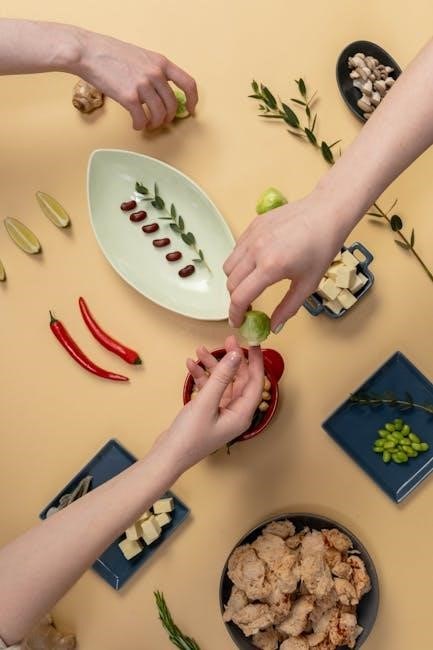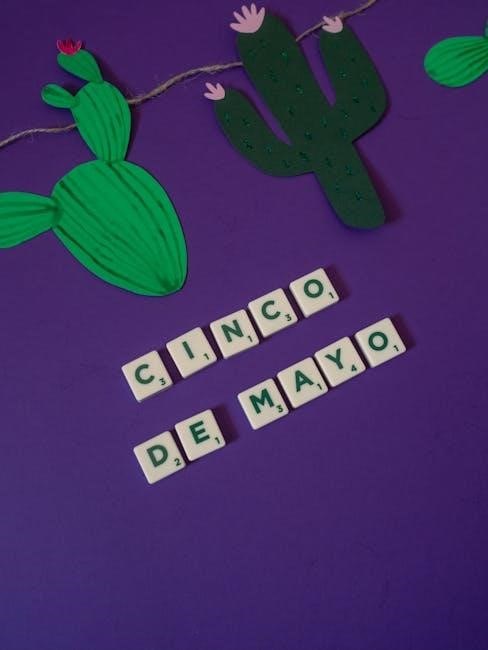I Am Not Your Perfect Mexican Daughter, a National Book Award finalist by Erika L․ Sánchez, explores cultural identity, family expectations, and self-discovery through Julia’s poignant journey․
This powerful YA novel delves into grief, tradition, and modernity, resonating deeply with Mexican-American experiences and offering a relatable voice for young readers navigating identity and belonging․
Overview of “I Am Not Your Perfect Mexican Daughter”
I Am Not Your Perfect Mexican Daughter is a poignant and often humorous YA novel by Erika L․ Sánchez, exploring themes of identity, grief, and cultural expectations․ The story follows Julia, a teenager navigating her aspirations and family traditions in a Mexican-American household․ Her sister Olga, perceived as the “perfect” daughter, dies, forcing Julia to confront her own desires and the pressures of her heritage․ The book seamlessly blends wit with heartache, offering a relatable voice for young readers grappling with identity and belonging․ Its acclaim includes being a National Book Award finalist and a New York Times bestseller․
Importance of the Book in Contemporary Literature
I Am Not Your Perfect Mexican Daughter holds significant importance in contemporary literature for its authentic portrayal of the Mexican-American experience․ It addresses themes of cultural identity, grief, and socioeconomic challenges, offering a raw and honest voice for underrepresented communities․ The novel bridges gaps in diversity by exploring the complexities of immigrant families and the struggles of balancing tradition with modern aspirations․ Its blend of humor and heartache resonates widely, making it a vital contribution to young adult literature and a powerful tool for fostering empathy and understanding in today’s diverse world․
Plot Summary
Julia navigates grief, cultural pressures, and self-discovery after her sister Olga’s death, challenging family expectations and exploring her identity in a Mexican-American context․
Setting and Background
The story unfolds in modern-day Chicago, focusing on the Mexican-American experience in a working-class neighborhood․ Julia’s family, having immigrated from Mexico, faces socioeconomic challenges and cultural pressures․ The vibrant yet troubled community on Chicago’s south side is marked by gang violence, poverty, and immigrant struggles․ Julia’s journey reflects the tensions between tradition and modernity, as she navigates her identity amidst the sacrifices her parents made for a better life․ The setting underscores the resilience and complexity of immigrant families, blending cultural heritage with contemporary urban life, shaping Julia’s aspirations and internal conflicts․
Julia, the protagonist, is a fiercely independent and creative teenager struggling to balance her ambitions with her family’s expectations․ Growing up in a working-class Mexican-American household, she feels stifled by traditional roles and yearns for a different future; Her sharp wit and passion for literature provide an escape, yet she grapples with grief, identity, and rebellion․ Julia’s journey is a raw exploration of self-discovery, as she navigates cultural pressures, family dynamics, and personal loss, striving to define herself beyond the expectations placed upon her as a “perfect Mexican daughter․”
The Role of Olga and Family Dynamics
Olga, Julias older sister, is portrayed as the ideal, obedient Mexican daughter, sacrificing her own desires to fulfill family expectations․ Her death shatters the family, revealing the weight of cultural obligations and the strain on relationships․ Julia struggles with her parents’ traditional values, feeling suffocated by the contrast between her aspirations and the role Olga embodied․ The tension between Julias independence and her parents’ expectations highlights the complexities of cultural identity and familial love, setting the stage for Julias journey of self-discovery and reconciliation with her heritage․
Key Events and Turning Points
Olga’s death serves as the catalyst, exposing Julia to the harsh realities of her sister’s life and the family’s unspoken secrets․ Julia discovers that Olga, the perceived “perfect” daughter, harbored her own desires and flaws․ This revelation challenges Julia’s perceptions and underscores the pressures of cultural expectations․ A pivotal moment occurs when Julia attempts suicide, forcing her to confront her mental health and aspirations․ Her decision to pursue college, despite her parents’ disapproval, marks a turning point in her struggle for independence․ These events highlight the tension between tradition and personal identity, driving Julia’s growth and resilience․

Characters
Julia, the rebellious protagonist, challenges traditional expectations, while her sister Olga embodies the ideal Mexican daughter․ Their parents represent cultural pressures, and supporting characters like Lorena influence Julia’s journey․
Julia: The Protagonist
Julia, the protagonist, is a rebellious and aspiring writer navigating her identity in a working-class Mexican-American family in Chicago․ Her sharp wit and defiance challenge traditional expectations, while her love for literature offers an escape from her harsh reality․ Struggling with cultural pressures and her parents’ disappointment, Julia’s journey is marked by grief, self-discovery, and resilience․ Her flawed yet relatable character captures the complexities of adolescence and the immigrant experience, making her a powerful and memorable voice in contemporary YA literature․
Olga: The Ideal Mexican Daughter
Olga embodies the traditional role of the “perfect Mexican daughter,” adhering to cultural expectations by staying home, caring for her parents, and forsaking personal ambitions; Her death exposes the cracks in this idealized image, revealing a complex individual with unfulfilled desires․ Through Julia’s reflections, Olga’s character evolves from a saintly figure to a multidimensional person, highlighting the pressures placed on women in Mexican-American households․ Her legacy serves as a catalyst for Julia’s journey of self-discovery and challenges the notion of perfection in cultural identity․
Julia’s Parents: Cultural Expectations and Conflict
Julia’s parents, shaped by their Mexican heritage and immigrant struggles, hold rigid cultural expectations, valuing tradition over personal aspirations․ They envision their daughters conforming to societal roles, with Olga embodying the ideal of a dutiful, home-bound daughter․ Julia, however, rebels against these constraints, creating tension within the family․ Their experiences as undocumented immigrants, marked by hardship and sacrifice, deepen their adherence to traditional values․ Amá’s constant pain and financial struggles, such as using Olga’s savings for a party, highlight the generational and cultural clash, illustrating the complex interplay between love, loss, and the pressures of cultural identity․
Supporting Characters and Their Influence
Lorena, Julia’s friend, offers a contrasting perspective on identity and ambition, while Mr․ Ingman, her teacher, encourages her writing dreams․ Minor characters like the coyotes who brought Julia’s parents to the U․S․ and the narcos in Mexico add depth to the family’s backstory․ These figures highlight the sacrifices and hardships shaping Julia’s parents’ expectations․ Through their interactions, Julia gains insight into her family’s past and the broader immigrant experience, influencing her journey of self-discovery and rebellion against cultural norms․ Each character plays a role in Julia’s evolving understanding of her identity and aspirations․

Themes
Cultural identity, family expectations, grief, self-discovery, and socioeconomic challenges are central to the novel, exploring the complexities of belonging and resilience in a Mexican-American context through Julia’s journey․
Cultural Identity and Family Expectations
The novel vividly portrays the tension between cultural identity and family expectations, particularly through Julia’s struggle to balance her ambitions with her parents’ traditional values․
Julia’s desire for independence clashes with her role as a Mexican daughter, highlighting the pressure to conform to societal norms while navigating personal aspirations and identity․
Family dynamics, shaped by immigrant experiences and cultural heritage, reveal the complexities of belonging and the sacrifices made by first-generation Americans in pursuit of a better life․
The interplay between tradition and modernity underscores Julia’s internal conflict, reflecting broader societal expectations and the challenges of preserving cultural roots in a changing world․
Grief and Loss
The novel poignantly explores grief and loss, particularly through Julia’s journey after her sister Olga’s death․ Olga, seen as the “perfect” daughter, leaves a void that Julia struggles to fill, grappling with guilt and unanswered questions․ The family’s shattered dynamics reveal the weight of unspoken emotions and the pressure to move forward․ Julia’s own suicide attempt and recovery highlight her internal battles with grief and identity․ The novel underscores how loss reshapes relationships and forces individuals to confront their vulnerabilities, ultimately revealing the resilience needed to heal and find hope amidst sorrow․
Self-Discovery and Independence
Julia’s journey is marked by her struggle to define herself beyond her family’s expectations․ Aspiring to be a writer, she rebels against the traditional role of a “perfect Mexican daughter,” seeking independence and self-expression․ Her experiences, including a suicide attempt and recovery, highlight her internal battle for autonomy and identity․ Through her travels to Mexico and exploration of her heritage, Julia begins to reconcile her cultural roots with her personal ambitions, ultimately embracing her uniqueness and finding the courage to pursue her own path in life, despite societal and familial pressures․
Socioeconomic Challenges
The novel vividly portrays the socioeconomic struggles faced by Julia’s family, highlighting the harsh realities of poverty and undocumented immigration․ Julia’s parents, having crossed the border illegally, endure exploitation and constant fear of deportation․ Their sacrifices, including her mother’s traumatic experience with coyotes, underscore the systemic oppression faced by immigrant families․ Financial constraints limit Julia’s opportunities, as her parents prioritize survival over education․ The death of Lorena’s father during the border crossing further illustrates the devastating impact of economic desperation and border violence on families like hers, shaping Julia’s understanding of resilience and sacrifice․

Author Background
Erika L․ Sánchez, born in Cicero, Illinois, to Mexican immigrants, earned a Fulbright Scholarship and MFA․ Her debut novel, a National Book Award finalist, explores immigrant experiences and family dynamics, gaining critical acclaim․
Erika L․ Sánchez: Biography
Erika L․ Sánchez, born in Cicero, Illinois, to Mexican immigrant parents, grew up in a working-class environment․ She earned a Fulbright Scholarship, an MFA, and published her debut poetry collection, Lessons on Expulsion, in 2017․ Her young adult novel, I Am Not Your Perfect Mexican Daughter, became a National Book Award finalist, acclaiming her as a powerful voice in contemporary literature․ Her work explores identity, culture, and family dynamics, resonating deeply with immigrant experiences․ Sánchez’s writing reflects her own journey, blending personal and cultural narratives․
Writing Style and Influences
Erika L․ Sánchez’s writing style blends humor with poignant themes, creating a biting and insightful narrative voice․ Her work is deeply influenced by her Mexican heritage and experiences growing up in Chicago, offering authentic portrayals of immigrant life․ Sánchez draws inspiration from classic literature, such as The Catcher in the Rye, and contemporary works like Jane the Virgin, weaving these influences into her unique storytelling․ Her ability to balance cultural depth with relatable teenage struggles has made her a standout voice in contemporary YA literature, resonating with readers seeking stories about identity and belonging․

Cultural Context
I Am Not Your Perfect Mexican Daughter reflects the complexities of the Mexican-American experience, exploring traditions, identity, and the tensions between cultural heritage and modern life․
Mexican-American Experience
I Am Not Your Perfect Mexican Daughter vividly portrays the Mexican-American experience, highlighting cultural heritage, identity struggles, and the challenges of immigration․ Set in Chicago, the novel explores the tension between traditional family values and modern aspirations․ Julia’s journey reflects the broader experiences of Mexican-Americans, navigating socioeconomic struggles, cultural expectations, and personal identity․ The book underscores the sacrifices immigrant parents make for their children’s futures, while also revealing the internal conflicts between preserving heritage and embracing new opportunities․ This resonant portrayal offers a powerful lens into the complexities of belonging and identity in a multicultural society․
Tradition vs․ Modernity
I Am Not Your Perfect Mexican Daughter delves into the clash between tradition and modernity, particularly through Julia’s struggles with her family’s cultural expectations․ Her parents, rooted in Mexican traditions, envision a conventional path for their daughters, while Julia yearns for independence and intellectual pursuits․ The novel highlights the tension between preserving heritage and embracing modern aspirations, as Julia navigates her desire for college and a writing career against the backdrop of her family’s sacrifices and expectations․ This conflict mirrors broader societal tensions faced by many Mexican-American youth striving to balance cultural identity with personal ambition․

Reception and Impact
I Am Not Your Perfect Mexican Daughter became a New York Times bestseller and a National Book Award finalist, praised for its raw portrayal of cultural identity and family dynamics․
Awards and Recognition
I Am Not Your Perfect Mexican Daughter received critical acclaim, becoming a National Book Award finalist and a New York Times bestseller․ Its raw portrayal of cultural identity and family dynamics resonated widely, earning it a place among the 2020 NYT 100 Notable Books․ The novel’s success led to a screen adaptation option by Anonymous Content, highlighting its cultural significance․ Erika L․ Sánchez’s work has been praised for its authentic voice, making it a pivotal contribution to young adult literature and a powerful exploration of the Mexican-American experience․
Reader and Critical Reviews
I Am Not Your Perfect Mexican Daughter has received widespread acclaim for its raw, emotional portrayal of cultural identity and family dynamics․ Readers praise Julia’s relatable struggle to balance tradition with personal ambition․ Critics highlight the novel’s vivid storytelling and its ability to blend humor with poignant themes of grief and self-discovery․ The book has resonated deeply with young adults, particularly those from immigrant backgrounds, offering a mirror to their experiences․ Its authenticity and emotional depth have solidified its place as a beloved and impactful YA novel, with resources like LitCharts further enhancing its study and appreciation․
Cultural Significance
I Am Not Your Perfect Mexican Daughter holds profound cultural significance, offering a raw and unfiltered look at the Mexican-American experience․ It bridges the gap between tradition and modernity, highlighting the sacrifices of immigrant parents and the struggles of first-generation youth․ The novel’s authenticity resonates deeply with readers, particularly those from immigrant backgrounds, providing a voice to their unspoken struggles․ Its exploration of identity, family, and resilience has made it a pivotal work in contemporary YA literature, fostering empathy and understanding across cultures while celebrating the richness of Mexican heritage and the complexity of belonging․

Analysis
I Am Not Your Perfect Mexican Daughter explores cultural identity, grief, and family dynamics through Julia’s journey, offering a raw, emotional portrayal of the immigrant experience and self-discovery․
Character Analysis
Julia, the protagonist, is a rebellious and ambitious teenager grappling with cultural expectations, grief, and identity․ Her journey reveals a complex, flawed character striving for independence․ Olga, her sister, initially appears as the ideal Mexican daughter but later exposes hidden depths, challenging Julia’s perceptions․ Their parents embody traditional values, creating tension with Julia’s modern aspirations․ Supporting characters like Lorena and Mr․ Ingman offer guidance, shaping Julia’s growth․ The novel’s character development highlights the struggles of identity, family, and societal expectations, making it deeply relatable and impactful․
Theme Analysis
The novel explores themes of cultural identity, as Julia navigates her Mexican heritage and American ambitions․ Grief and loss shape her family dynamics, especially after Olga’s death․ Self-discovery emerges as Julia challenges societal and familial expectations to forge her own path; The struggle between tradition and modernity highlights the tensions within immigrant families; Additionally, socioeconomic challenges underscore the harsh realities of poverty and exploitation․ These themes intertwine to create a rich tapestry of identity, family, and resilience, making the book a compelling exploration of contemporary issues․
Symbolism in the Novel
Books serve as a symbol of escape and intellectual freedom for Julia, representing her desire to transcend her limited environment․ Olga’s death symbolizes the shattering of the “perfect Mexican daughter” ideal, revealing complexities beneath the surface․ The border between Mexico and the U․S․ symbolizes the divide between Julia’s heritage and her American aspirations․ La Virgen de Guadalupe embodies traditional cultural expectations, contrasting with Julia’s modern identity․ These symbols weave together to illustrate the protagonist’s journey toward self-discovery and cultural reconciliation․

Study Guide Elements
A comprehensive study guide for I Am Not Your Perfect Mexican Daughter includes chapter summaries, discussion questions, and in-depth analysis of themes, characters, and cultural significance to enhance understanding and engagement․
Chapter Summaries

The study guide provides a detailed breakdown of each chapter in I Am Not Your Perfect Mexican Daughter, offering insights into Julia’s journey of self-discovery and grief․ Each summary highlights key events, character development, and thematic elements, such as Julia’s strained relationship with her parents and her aspirations beyond her cultural expectations․ The guide also explores the aftermath of Olga’s death, revealing hidden truths about her life and the family’s struggles․ This section helps readers understand the novel’s emotional depth and its exploration of identity, tradition, and resilience․
Discussion Questions
How does Julia’s desire to attend college conflict with her parents’ expectations, and what does this reveal about cultural differences?
In what ways does Olga’s character serve as a symbol of the “perfect Mexican daughter,” and how does Julia respond to this ideal?
How does the novel portray grief and loss, particularly through Julia’s emotional journey after her sister’s death?
What role does identity play in shaping Julia’s relationships and decisions?
How does the novel highlight the challenges of growing up in a Mexican-American household?
What message do you think the author is conveying about balancing tradition and personal aspirations?
How does Julia’s love for reading influence her perspective on her life and future?
What does the novel suggest about the importance of family and individuality?
How does the setting of Chicago impact Julia’s experiences and identity?
What does the book ultimately say about the struggle to define oneself within cultural expectations?
Teaching Strategies
Engage students by discussing cultural identity and family expectations, encouraging personal reflections on their own heritage․ Use the novel to explore themes of grief, self-discovery, and socioeconomic challenges․ Incorporate reflective writing prompts, such as analyzing Julia’s internal conflicts or the symbolism of books in her life․ Create character maps to trace Julia’s growth and relationships․ Encourage group discussions on the tension between tradition and modernity․ Integrate interdisciplinary connections, such as exploring the historical context of Mexican immigration or analyzing the novel’s literary style․ Foster empathy by role-playing family dynamics or debating societal expectations․

Legacy and Adaptations
I Am Not Your Perfect Mexican Daughter has been optioned for screen adaptation by Anonymous Content, highlighting its potential to reach broader audiences․ Its impact on YA literature is significant, offering a fresh voice to Mexican-American stories and inspiring future adaptations that celebrate diverse narratives․
Screen Adaptation Potential
I Am Not Your Perfect Mexican Daughter has been optioned for screen adaptation by Anonymous Content, the producers of 13 Reasons Why․ Its poignant exploration of cultural identity, grief, and self-discovery, combined with its relatable protagonist Julia, makes it a compelling candidate for film or series adaptation․ The novel’s vivid portrayal of family dynamics and personal growth could resonate deeply with audiences, offering a powerful visual narrative that expands its reach beyond the page․ This adaptation has the potential to further amplify the book’s cultural significance and emotional impact․
Impact on Young Adult Literature
I Am Not Your Perfect Mexican Daughter has made a significant impact on young adult literature by offering a raw, authentic voice to the Mexican-American experience․ Its exploration of cultural identity, grief, and self-discovery resonates deeply with young readers, filling a gap in diverse storytelling․ The novel’s success has paved the way for more stories highlighting underrepresented voices, emphasizing the importance of inclusivity in YA literature․ Its critical acclaim and resonance with readers underscore its lasting influence on the genre, making it a landmark work in contemporary young adult fiction․
I Am Not Your Perfect Mexican Daughter leaves readers with a powerful message about identity, family, and resilience․ Its unflinching honesty and relatable themes make it a timeless read for young adults and beyond, encouraging deeper reflection on cultural heritage and personal growth․
Final Thoughts on the Book’s Message
I Am Not Your Perfect Mexican Daughter delivers a profound exploration of identity, family, and resilience․ Through Julia’s journey, the novel highlights the struggles of balancing cultural expectations with personal aspirations, offering a relatable and authentic voice for young readers․ It emphasizes the importance of self-discovery and the strength found in embracing one’s true self, even in the face of societal pressures and family dynamics․ The book’s message of empowerment and understanding resonates deeply, making it a vital read for anyone navigating identity and belonging․
Encouragement for Further Reading
Readers captivated by Julia’s journey are encouraged to explore Erika L․ Sánchez’s other works, including her poetry collection Lessons on Expulsion․ For those drawn to stories of cultural identity and family dynamics, books like The Distance Between Us by Reyna Grande or The Poet X by Elizabeth Acevedo offer similar themes․ These narratives provide deeper insights into the immigrant experience and the struggle for self-discovery, enriching your understanding of the Mexican-American journey and its complexities․































